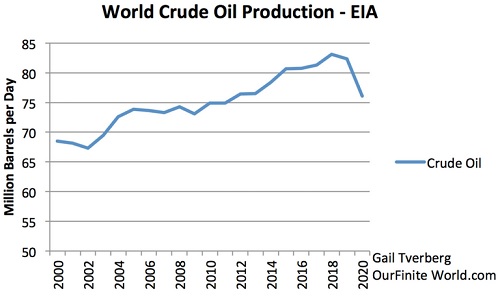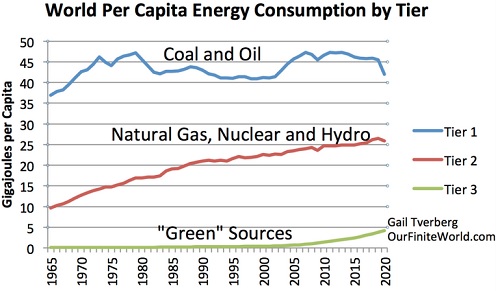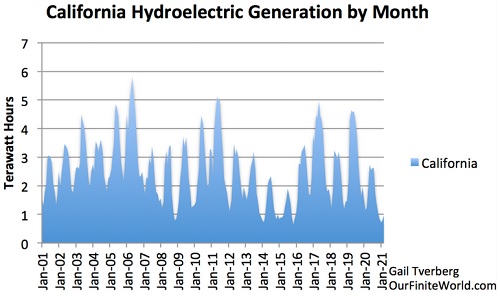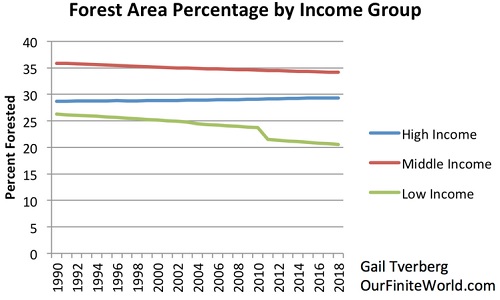I have written many posts relating to the fact that we live in a finite world. At some point, our ability to extract resources becomes constrained. At the same time, population keeps increasing. The usual outcome when population is too high for resources is “overshoot and collapse.” But this is not a topic that the politicians or central bankers or oligarchs who attend the World Economic Forum dare to talk about.
Instead, world leaders find a different problem, namely climate change, to emphasize above other problems. Conveniently, climate change seems to have some of the same solutions as “running out of fossil fuels.” So, a person might think that an energy transition designed to try to fix climate change would work equally well to try to fix running out of fossil fuels. Unfortunately, this isn’t really the way it works.
In this post, I will lay out some of the issues involved.
[1] There are many different constraints that new energy sources need to conform to.
These are a few of the constraints I see:
- Should be inexpensive to produce
- Should work with the current portfolio of existing devices
- Should be available in the quantities required, in the timeframe needed
- Should not pollute the environment, either when created or at the end of their lifetimes
- Should not add CO2 to the atmosphere
- Should not distort ecosystems
- Should be easily stored, or should be easily ramped up and down to precisely match energy timing needs
- Cannot overuse fresh water or scarce minerals
- Cannot require a new infrastructure of its own, unless the huge cost in terms of delayed timing and greater materials use is considered.
If an energy type is simply a small add-on to the existing system, perhaps a little deviation from the above list can be tolerated, but if there is any intent of scaling up the new energy type, all of these requirements must be met.
It is really the overall cost of the system that is important. Historically, the use of coal has helped keep the overall cost of the system down. Substitutes need to be developed considering the overall needs and cost of the system.
The reason why the overall cost of the system is important is because countries with high-cost energy systems will have a difficult time competing in a world market since energy costs are an important part of the cost of producing goods and services. For example, the cost of operating a cruise ship depends, to a significant extent, on the cost of the fuel it uses.
In theory, energy types that work with different devices (say, electric cars and trucks instead of those operated by internal combustion engines) can be used, but a long delay can be expected before a material shift in overall energy usage occurs. Furthermore, a huge ramp up in the total use of materials for production may be required. The system cannot work if the total cost is too high, or if the materials are not really available, or if the timing is too slow.
[2] The major thing that makes an economy grow is an ever increasing supply of inexpensive-to-produce energy products.
Food is an energy product. Let’s think of what happens when agriculture is mechanized, typically using devices that are made and operated using coal and oil. The cost of producing food drops substantially. Instead of spending, for example, 50% of a person’s wages on food, the percentage can gradually drop down to 20% of wages, and then to 10% of wages for food, and eventually even, say, to 2% of wages for food.
As spending on food falls, opportunity for other spending arises, even with wages remaining relatively level. With lower food expenditures, a person can spend more on books (made with energy products), or personal transportation (such as a vehicle), or entertainment (also made possible by energy products). Strangely enough, in order for an economy to grow, essential items need to become an ever decreasing share of everyone’s budget, so that citizens have sufficient left-over income available for more optional items.
It is the use of tools, made and operated with inexpensive energy products of the right types, that leverages human labor so that workers can produce more food in a given period of time. This same approach also makes many other goods and services available.
In general, the less expensive an energy product is, the more helpful it will be to an economy. A country operating with an inexpensive mix of energy products will tend to be more competitive in the world market than one with a high-cost mix of energy products. Oil tends to be expensive; coal tends to be inexpensive. This is a major reason why, in recent years, countries using a lot of coal in their energy mix (such as China and India) have been able to grow their economies much more rapidly than those countries relying heavily on oil in their energy mixes.
[3] If energy products are becoming more expensive to produce, or their production is not growing very rapidly, there are temporary workarounds that can hide this problem for quite a number of years.
Back in the 1950s and 1960s, world coal and oil consumption were growing rapidly. Natural gas, hydroelectric and (a little) nuclear were added, as well. Cost of production remained low. For example, the price of oil, converted to today’s dollar value, was less than $20 per barrel.
Once the idyllic 1950s and 1960s passed, it was necessary to hide the problems associated with the rising cost of production using several approaches:
- Increasing use of debt – really a promise of future goods and services made with energy
- Lower interest rates – permits increasing debt to be less of a financial burden
- Increasing use of technology – to improve efficiency in energy usage
- Growing use of globalization – to make use of other countries’ cheaper energy mix and lower cost of labor
After 50+ years, we seem to be reaching limits with respect to all of these techniques:
- Debt levels are excessive
- Interest rates are very low, even below zero
- Increasing use of technology as well as globalization have led to greater and greater wage disparity; many low level jobs have been eliminated completely
- Globalization has reached its limits; China has reached a situation in which its coal supply is no longer growing
[4] The issue that most people fail to grasp is the fact that with depletion, the cost of producing energy products tends to rise, but the selling prices of these energy products do not rise enough to keep up with the rising cost of depletion.
As a result, production of energy products tends to fall because production becomes unprofitable.
As we get further and further away from the ideal situation (oil less than $20 per barrel and rising in quantity each year), an increasing number of problems crop up:
- Both oil/gas companies and coal companies become less profitable.
- With lower energy company profits, governments can collect less taxes from these companies.
- As old wells and mines deplete, the cost of reinvestment becomes more of a burden. Eventually, new investment is cut back to the point that production begins to fall.
- With less growth in energy consumption, productivity growth tends to lag. This happens because energy is required to mechanize or computerize processes.
- Wage disparity tends to grow; workers become increasingly unhappy with their governments.
[5] Authorities with an incorrect understanding of why and how energy supplies fall have assumed that far more fossil fuels would be available than is actually the case. They have also assumed that relatively high prices for alternatives would be acceptable.
In 2012, Jorgen Randers prepared a forecast for the next 40 years for The Club of Rome, in the form of a book, 2052, with associated data. Looking at the data, we see that Randers forecast that world coal consumption would grow by 28% between 2010 and 2020. In fact, world coal consumption grew by 0% in that period. (This latter forecast is based on BP coal consumption estimates for 2010 and 2019 from BP’s Statistical Review of World Energy 2020, adjusted for the 2019 to 2020 period change using IEA’s estimate from its Global Energy Review 2021.)
It is very easy to assume that high estimates of coal resources in the ground will lead to high quantities of actual coal extracted and burned. The world’s experience between 2010 and 2020 shows that it doesn’t necessarily work out that way in practice. In order for coal consumption to grow, the delivered price of coal needs to stay low enough for customers to be able to afford its use in the end products it provides. Much of the supposed coal that is available is far from population centers. Some of it is even under the North Sea. The extraction and delivery costs become far too high, but this is not taken into account in resource estimates.
Forecasts of future natural gas availability suffer from the same tendency towards over-estimation. Randers estimated that world gas consumption would grow by 40% between 2010 and 2020, when the actual increase was 22%. Other authorities make similar overestimates of future fuel use, assuming that “of course,” prices will stay high enough to enable extraction. Most energy consumption is well-buried in goods and services we buy, such as the cost of a vehicle or the cost of heating a home. If we cannot afford the vehicle, we don’t buy it; if the cost of heating a family’s home rises too high, thrifty families will turn down the thermostat.
Oil prices, even with the recent run-up in prices, are under $75 per barrel. I have estimated that for profitable oil production (including adequate funds for high-cost reinvestment and sufficient taxes for governments), oil prices need to be over $120 per barrel. It is the lack of profitability that has caused the recent drop in production. These profitability problems can be expected to lead to more production declines in the future.
With this low-price problem, fossil fuel estimates used in climate model scenarios are almost certainly overstated. This bias would be expected to lead to overstated estimates of future climate change.
The misbelief that energy prices will always rise to cover higher costs of production also leads to the belief that relatively high-cost alternatives to fossil fuels would be acceptable.
[6] Our need for additional energy supplies of the right kinds is extremely high right now. We cannot wait for a long transition. Even 30 years is too long.
We saw in section [3] that the workarounds for a lack of growing energy supply, such as higher debt and lower interest rates, are reaching limits. Furthermore, prices have been unacceptably low for oil producers for several years. Not too surprisingly, oil production has started to decline:
![]()

Figure 1 – World production of crude oil and condensate, based on data of the US Energy Information Administration.
|
What is really needed is sufficient energy of the right types for the world’s growing population. Thus, it is important to look at energy consumption on a per capita basis. Figure 2 shows energy production per capita for three groupings:
- Tier 1: Oil and Coal
- Tier 2: Natural Gas, Nuclear, and Hydroelectric
- Tier 3: Other Renewables, including Intermittent Wind and Solar
![]()

Figure 2 World per capita energy consumption by Tier. Amounts through 2019 based on BP Statistical Review of World Energy 2020. Changes for 2020 based on estimates provided by IEA Global Energy Review 2021.
|
Figure 2 shows that the biggest drop is in Tier 1: Coal and Oil. In many ways, coal and oil are foundational types of energy for the economy because they are relatively easy to transport and store. Oil is important because it is used in operating agricultural machinery, road repair machinery, and vehicles of all types, including ships and airplanes. Coal is important partly because of its low cost, helping paychecks to stretch further for finished goods and services. Coal is used in many ways, including electricity production and making steel and concrete. We use coal and oil to keep electricity transmission lines repaired.
Figure 2 shows that Tier 2 energy consumption per capita was growing rapidly in the 1965 to 1990 period, but its growth has slowed in recent years.
The Green Energy sources in Tier 3 have been growing rapidly from a low base, but their output is still tiny compared to the overall output that would be required if they were to substitute for energy from both Tier 1 and Tier 2 sources. They clearly cannot by themselves power today’s economy.
It is very difficult to imagine any of the Tier 2 and Tier 3 energy sources being able to grow without substantial assistance from coal and oil. All of today’s Tier 2 and Tier 3 energy sources depend on coal and oil at many points in the chain of their production, distribution, operation, and eventual recycling. If we ever get to Tier 4 energy sources (such as fusion or space solar), I would expect that they too will need oil and/or coal in their production, transport and distribution, unless there is an incredibly long transition, and a huge change in energy infrastructure.
[7] It is easy for energy researchers to set their sights too low.
[a] We need to be looking at the extremely low energy cost structure of the 1950s and 1960s as a model, not some far higher cost structure.
We have been hiding the world’s energy problems for years behind rising debt and falling interest rates. With very high debt levels and very low interest rates, it is becoming less feasible to stimulate the economy using these approaches. We really need very inexpensive energy products. These energy products need to provide a full range of services required by the economy, not simply intermittent electricity.
Back in the 1950s and 1960s, the ratio of Energy Earned to Energy Investment was likely in the 50:1 range for many energy products. Energy products were very profitable; they could be highly taxed. The alternative energy products we develop today need to have similar characteristics if they truly are to play an important role in the economy.
[ b] A recent study says that greenhouse gas emissions related to the food system account for one-third of the anthropogenic global warming gas total. A way to grow sufficient food is clearly needed.
We clearly cannot grow food using intermittent electricity. Farming is not an easily electrified endeavor. If we do not have an alternative, the coal and oil that we are using now in agriculture really needs to continue, even if it requires subsidies.
[c] Hydroelectric electricity looks like a good energy source, but in practice it has many deficiencies.
Some of the hydroelectric dams now in place are over 100 years old. This is nearing the lifetime of the concrete in the dams. Considerable maintenance and repair (indirectly using coal and oil) are likely to be needed if these dams are to continue to be used.
The water available to provide hydroelectric power tends to vary greatly over time. Figure 3 shows California’s hydro electricity generation by month.
![]()

Figure 3. California hydroelectric energy production by month, based on data of the US Energy Information Administration.
|
Thus, as a practical matter, hydroelectric energy needs to be balanced with fossil fuels to provide energy which can be used to power a factory or heat a home in winter. Battery storage would never be sufficient. There are too many gaps, lasting months at a time.
If hydroelectric energy is used in a tropical area with dry and wet seasons, the result would be even more extreme. A poor country with a new hydroelectric power plant may find the output of the plant difficult to use. The electricity can only be used for very optional activities, such as bitcoin mining, or charging up small batteries for lights and phones.
Any new hydroelectric dam runs the risk of taking away the water someone else was depending upon for irrigation or for their own electricity generation. A war could result.
[d] Current approaches for preventing deforestation mostly seem to be shifting deforestation from high income countries to low income countries. In total, deforestation is getting worse rather than better.
![]()

Figure 4. Forest area percentage of land area, by income group, based on data of the World Bank.
|
Figure 4 shows that deforestation is getting rapidly worse in Low Income countries with today’s policies. There is also a less pronounced trend toward deforestation in Middle Income countries. It is only in High Income countries that land areas are becoming more forested. In total (not shown), the forested area for the world as a whole falls, year after year.
Also, even when replanting is done, the new forests do not have the same characteristics as those made by natural ecosystems. They cannot house as many different species as natural ecosystems. They are likely to be less resistant to problems like insect infestations and forest fires. They are not true substitutes for the forest ecosystems that nature creates.
[e] The way intermittent wind and solar have been added to the electric grid vastly overpays these providers, relative to the value they add to the system. Furthermore, the subsidies for intermittent renewables tend to drive out more stable producers, degrading the overall condition of the grid.
If wind and solar are to be used, payments for the electricity they provide need to be scaled back to reflect the true value that they add to the overall system. In general, this corresponds to the savings in fossil fuel purchases that electricity providers need to make. This will be a small amount, perhaps 2 cents per kilowatt hour. Even this small amount, in theory, might be reduced to reflect the greater electricity transmission costs associated with these intermittent sources.
We note that China is making a major step in the direction of reducing subsidies for wind and solar. It has already dramatically cut its subsidies for wind energy; new subsidy cuts for solar energy will become effective August 1, 2021.
A major concern is the distorting impact that current pricing approaches for wind and solar have on the overall electrical system. Often, these approaches produce very low, or negative, wholesale prices for other providers. Nuclear providers are especially harmed by such practices. Nuclear is, of course, a low CO2 electricity provider.
It seems to me that in each part of the world, some utility-type provider needs to be analyzing what the overall funding of the electrical system needs to be. Bills to individuals and businesses need to reflect these actual expected costs. This approach might avoid the artificially low rates that the current pricing system often generates. If adequate funding can be achieved, perhaps some of the corner cutting that leads to electrical outages, such as recently encountered in California and Texas, might be avoided.
[8] When I look at the requirements for a successful energy transition and the obstacles we are up against, it is hard for me to see that any of the current approaches can be successful.
Unfortunately, it is hard for me to see how intermittent electricity can save the world economy, or even make a dent in our problems. We have searched for a very long time, but haven’t yet found solutions truly worth ramping up. Perhaps a new “Tier 4 approach” might be helpful, but such solutions seem likely to come too late.
|
ABOUT THE AUTHOR
Gail Tverberg is an actuary interested in finite world issues - oil depletion, natural gas depletion, water shortages, and climate change. Oil limits look very different from what most expect, with high prices leading to recession, and low prices leading to financial problems for oil producers and for oil exporting countries. We are really dealing with a physics problem that affects many parts of the economy at once, including wages and the financial system. She tries to look at the overall problem.
|